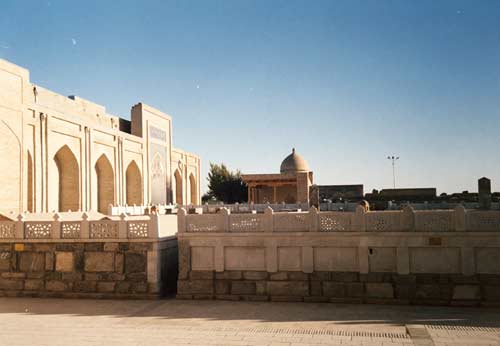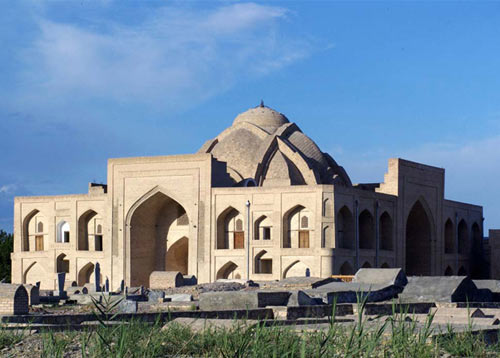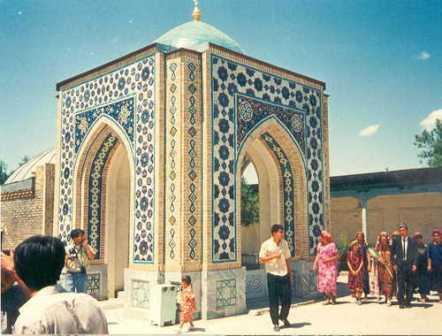|
Category
|
The memorial complex of Bakhouddin Naqshband
Bakhouddin Muhammad Naqshbandi Bukhari (1314-1389) was born in Bukhara, in the village of Kasri Orifon ("Castle of known the divine truth"). Sheikh’s Mother - Bibi Orifa was kind of the "Sayid", ie the descendants of the Prophet Muhammad. His father was a craftsman - chaser, why Sheikh earned the nickname "Naqshband" (Chaser). According to legend, before the birth of Bahauddin Naqshband, is one of the Seven Saints “Peers” (Teachers) of Sufism - Khoja Muhammad Boboi Samosi felt imminent birth of a great man and asked the sheikh of the future education to other feasts of the Seven Peers - Syed Amir Kulol. In early childhood, Sheikh Bakhouddin received spiritual initiation from Abdulkholiq Gijduvani Hodge, wich dead for 150 years before the birth of Naqshbandi, and who came to him in a dream and told him to become a disciple of Sheikh Amir Kulol. Under the guidance of their mentors Boboi Samosi and Amir Kulol, the young Bakhouddin understands the teachings of truth. At age 7 years he knows by heart the Koran. He continued his studies with Arif Diggarani, with whom he spends seven months. He then spent 12 years in the community with Sufi teachers Qosim Sheikh and Khalil-ata from Yasawia Order. Soon he returned to his native village, where he created own Sufi school. He left home in Bukhara only three times: twice to perform the Hajj, and a third time to visit Herat (Afghanistan). Starting from the XV century, Naqshbandi brotherhood has become one of the most widespread Sufi orders in the world. Naqshbandi Sufi community rejected the ostentatious asceticism and is actively engaged in economic activities. Naqshbandi is not called upon his followers to the hermit, on the contrary, it obliges them to be diligent farmers, artisans, traders, hold public office. Order peacefully coexisted with official Islam. He has said: "Our way to God - two-way communication, but not a hermit." However, he disapproved of ostentatious forty-day fast, vagrancy, public zeal (“sama”) with music and dancing and the loud “zikr” ("remembrance", Islamic religious practice). Naqshbandi Teachings negative attitude to life at another's expense. Naqshbandi followers believed correct, clean ("Halol"), only those funds that are obtained in the work, the sweat of his brow. This rule Naqshbandi laid the foundation of his teaching. His famous motto is "Dil ba Yoru, dast ba kor!" (Heart to God, hands to work!) is still popular among the people. Widespread acceptance in the Muslim world, Sheikh received during his three-year pilgrimage. In the future it will become the patron of crafts.
“Silsila”, it is a chain of succession (the Arabic word "silsila" - a chain line) of Naqshbandi Tariqah (the teachings) different branches back to the caliphs Abu Bakr and Ali. The presence of the chain is necessary for any Tariqa as is one indication of the true line of succession to the teachers. In a true Silsilah transmitted divine grace - "barracka." Naqshbandi is tarikats, sticking creed of "quiet zikr". Naqshbandi’s zikr, which together make the Sufis called "Hatmi Khodjagon." The teaching fraternity amounted to 11 ethical principles, eight of which were inherited from the Sufi school Khodjagon, and three developed by the Naqshbandi. According to legend, a young man Bakhouddin was a weaver, specializing in the manufacture of silk with gold embroidery. It is believed that before the advent of Islam, located on the site of a pagan temple complex is associated with a holiday "red rose".  Bahauddin Naqshbandi memorial complex built up over five centuries. The ensemble took to the XVI century, form of a combination of the necropolis of ceremonial building. In 1544 by Abdul Aziz Khan Naqshbandi’s disposal has been issued in the form of ground vault – “dakhma” with marble carved railing. A little further was built “khanaka” - the largest of the known buildings such appointment (42.5 m * 38 m). Adoration of the holy tomb of Sheikh equated Hajj to Mecca. Other attractions of complex are the Painted Muzaffar Khan (XVI c.) and Hakim Kushbegi Mosques and picturesque four-arch "sakkohona" (thirst quencher room). In front of a Kushbegi mosque rises minaret and small madrasas. To the west is a vast necropolis “dakhma” - vault of Bukhara rulers.
On the waterfront is the trunk of a dry mulberry ritual tree. Many famous people, which mentions the story of Bukhara, were buried here, in the vast cemetery at west of the “dakhma”. During the Soviet period, the shrine was in a state of desolation. Since independence of Uzbekistan in honor of the 675th anniversary of Bahauddin Naqshband in 1993, the shrine was restored. On the initiative of Uzbek President Islam Karimov in 2003 were a lot of work on the improvement of the complex. It was built "darvazahana" (input space) with a high dome. Were recreated richly decorated “ayvans” - terraces. The extensive gardens combined into a single composition of Hazrat Bahauddin sacred burial and burial place of his mother. There was also restored Dahmai Shohon (Necropolis of the Rulers). Spirituality expressive architectural structures, silence and solitude of the ensemble causes the pursuit of knowing God. |
 Not far from Bukhara is a memorial to the patron saint of Bukhara - Sheikh Bahauddin Naqshband.
Not far from Bukhara is a memorial to the patron saint of Bukhara - Sheikh Bahauddin Naqshband. In Timurids time the Order had a major impact on both the rulers and the masses. The members of this fraternity was an outstanding Persian poet Jami and the great Uzbek poet Alisher Navoi.
In Timurids time the Order had a major impact on both the rulers and the masses. The members of this fraternity was an outstanding Persian poet Jami and the great Uzbek poet Alisher Navoi. Of particular interest is a picturesque arch “sakkohona”. Sakkohona – in the eastern traditions may be a small building, a niche in the wall, or even just a ledge where there is a faucet, fountain or a pitcher who is usually mounted behind the iron bars. Passers-by can not only quench your thirst here, but also ask about the performance of pious wishes, leaving here a small gift (as a pledge of wish-fulfillment).
Of particular interest is a picturesque arch “sakkohona”. Sakkohona – in the eastern traditions may be a small building, a niche in the wall, or even just a ledge where there is a faucet, fountain or a pitcher who is usually mounted behind the iron bars. Passers-by can not only quench your thirst here, but also ask about the performance of pious wishes, leaving here a small gift (as a pledge of wish-fulfillment).














